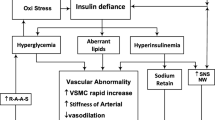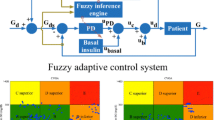Abstract
Here, a multi-input–output control strategy-based adaptive system is implemented to regulate the glycaemic and hypertension (HT) level concurrently for post-operative patients. The current medical research identifies the relationship between diabetes and HT, and these two diseases have possible overlap in their disease aetiology. Based on the continuum, the blood glucose and blood pressure (BP) have to be measured independently and control the infusion to maintain optimally based on the variations of diabetic mellitus and HT to avoid the major complications for the perioperative condition. Based on the analysis, the post-operative strain may increase HT and may increase the glycaemic level, and this uncertainty of disparity may lead to BP, hyperinsulinemia, cardio diseases, and osmotic diuresis along with hyperglycaemia. The proposed adaptive cascade control strategy illustrates two different types of control loops independently, and these loops adopt an adaptive control strategy with parametric compensation. This adaptive control algorithm integrates the cascade methodology along with expert knowledge to treat these diseases by using adaptation laws with the help of fuzzy logic to regulate the proper insulin and sodium nitroprusside (SNP) infusion. The output response of the plasma glucose concentration and HT regulation was shown along with insulin infusion rate and SNP infusion rate based on the extensive simulation readings. The attained simulation results demonstrate that the adaptive control strategy shows better outcomes for the infusion and may achieve potentially better control on HT and glycaemic levels for post-operative patients.






Similar content being viewed by others
References
Gurushankar G, Showers JR et al (2006) Hypertension and diabetes mellitus. In: European cardiovascular disease—Reference section, pp 1–5
Wild S, Roglic G, Green A, Sicree R, King H (2004) Global prevalence of diabetes: estimates for the year 2000 and projections for 2030. Diabetes Care 27(5):1047–1053
Slate JB, Sheppard LC, Rideout VC, Blackstone EH (1979) A model for design of a blood pressure controller for hypertensive patients. In: Proceedings of the IEEE EMBS conference, pp 867–72
Parthasarathy P, Vivekanandan S (2018) A numerical modelling of an amperometric-enzymatic based uric acid biosensor for GOUT arthritis diseases. Inf Med Unlocked 12:143–147
Slate JB, Sheppard LC (1982) A model-based adaptive blood pressure controller. In: Proceedings of IFAC symposium on identification and system parameter estimation, Washington, pp 1437–1442
Parthasarathy P, Vivekanandan S (2018) Investigation on uric acid biosensor model for enzyme layer thickness for the application of arthritis disease diagnosis. Health Inf Sci Syst 6(1):5
Alavudeen Basha A, Vivekanandan S (2019) Enhanced optimal insulin regulation in post-operative diabetic patients: an adaptive cascade control compensation-based approach with diabetic and hypertension. IEEE Access 7:90973–90981
Cheung BMY, Li C (2012) Diabetes and hypertension: is there a common metabolic pathway. Coron Heart Dis 14:160–166
Mugo MN, Stump CS, Rao PG et al (2007) Hypertension and diabetes mellitus. In: Black HR, Elliott WJ (eds) Hypertension: a companion to Braunwald’s heart disease. Elsevier, Amsterdam, p 409
Basha AA, Vivekanandan S, Parthasarathy P (2018) Evolution of blood pressure control identification in lieu of post-surgery diabetic patients: a review. Health Inf Sci Syst 6(1):17
ADA (2002) Standards of medical care for patients with diabetes mellitus. Diabetes Care 25(1):533–549
Landsberg L, Molitch M (2004) Diabetes and hypertension: pathogenesis, prevention and treatment. Clin Exp Hypertens 26:621–628
Gress TW, Nieto FJ, Shahar E et al (2000) Hypertension and antihypertensive therapy as risk factors for type 2 diabetes mellitus. Atherosclerosis Risk in Communities Study. N Engl J Med 342:905–912
Alavudeen Basha A, Vivekanandan S, Parthasarathy P (2019) Blood glucose regulation for post-operative patients with diabetics and hypertension continuum: a cascade control-based approach. J Med Syst 43(4):1–10
Zeggini E, Scott LJ, Saxena R et al (2008) Meta-analysis of genomewide association data and large-scale replication identifies additional susceptibility loci for type 2 diabetes. Nat Genet 40:638–645
Parthasarathy P, Vivekanandan S (2020) A typical IoT architecture-based regular monitoring of arthritis disease using time wrapping algorithm. Int J Comput Appl 42(3):222–232. https://doi.org/10.1080/1206212X.2018.1457471
Sober S, Org E, Kepp K et al (2009) Targeting 160 candidate genes for blood pressure regulation with a genome-wide genotyping array. PLoS ONE 4:e6034
Parthasarathy P, Vivekanandan S (2018) A comprehensive review on thin film-based nano-biosensor for uric acid determination: arthritis diagnosis. World Rev Sci Technol Sustain Dev 14(1):52–71
Bequette BW (2003) Process control: modeling, design, and simulation. Prentice-Hall, Inc., Upper Saddle River
Alavudeen Basha S, Vivekanandan S (2017) Evolution of diabetic control identification in lieu of continuous glucose monitoring technology—a review. Int J Appl Eng Res 12(16):6102–6107
Meier R, Nieuwland J, Zbinden AM, Hacisalihzade SS (1992) Fuzzy logic control of blood pressure during anesthesia. IEEE Control Syst Mag 12(6):12–16
Bergman RN, Ider YZ, Bowden C, Cobelli C (1979) Quantitative estimation of insulin sensitivity. Am Physiol Soc 236(6):E667–E677
Vijayarajeswari R, Parthasarathy P, Vivekanandan S, Alavudeen Basha A (2019) Classification of mammogram for early detection of breast cancer using SVM classifier and Hough transform. Measurement 146:800–805
Bergman RN, Urquhart J (1971) The pilot gland approach to the study of insulin secretory dynamics. Recent Prog Horm Res 27:583–605
Ganesh J, Viswanathan V (2011) Management of diabetic hypertensives. Indian J Endocrinol Metab 15(Supplement 4):374–379
Varon J, Marik PE (2008) Perioperative hypertension management. Vasc Health Risk Manag Hypertens 4(3):615–627
Dagogo-Jack Samuel (2002) Management of diabetes mellitus in surgical patients. Diabetes Spectr 15(1):44–48
Al-Niaimi AN, Hartenbach E (2015) Intensive postoperative glucose control reduces the surgical site infection rates in gynecologic oncology patients. Gynecol Control 136(1):71–76
Parthasarathy P, Vivekanandan S (2019) Biocompatible TiO2–CeO2 nano-composite synthesis, characterization and analysis on electrochemical performance for uric acid determination. Ain Shams Eng J. https://doi.org/10.1016/j.asej.2019.11.011
Bailey JM, Haddad WM (2005) Drug dosing control in clinical pharmacology. IEEE Control Syst Mag 25(2):35–51
Basha AA, Vivekanandan S (2017) Optimal control identification of IMC and PID controllers for insulin infusion. In: Proceedings of International Conference on Current Trends in Computer, Electrical, Electronics and Communication, pp 679–682
Varadharajan R, Priyan MK, Panchatcharam P, Vivekanandan S, Gunasekaran M (2018) A new approach for prediction of lung carcinoma using back propagation neural network with decision tree classifiers. J Ambient Intell Human Comput. https://doi.org/10.1007/s12652-018-1066-y
Sherr J, Tamborlane W (2008) Past, present, and future if insulin pump therapy: a better shot at diabetes control. Mt Sinai J Med 75:352–361
Al-Tabakha MM, Arida AI (2008) Recent challenges in insulin delivery systems: a review. Indian J Pharm Sci 70:278–286
Mathan K, Kumar PM, Panchatcharam P, Manogaran G, Varadharajan R (2018) A novel Gini index decision tree data mining method with neural network classifiers for prediction of heart disease. Des Autom Embed Syst 22:225–242. https://doi.org/10.1007/s10617-018-9205-4
Driankov D, Hellendoorn H, Reinfrank M (1996) An introduction to fuzzy control, 2nd edn. Springer, Berlin
Author information
Authors and Affiliations
Corresponding author
Ethics declarations
Conflict of interest
There is no conflict of interest from both the authors.
Additional information
Publisher's Note
Springer Nature remains neutral with regard to jurisdictional claims in published maps and institutional affiliations.
Rights and permissions
About this article
Cite this article
Alavudeen Basha, A., Vivekanandan, S. A fuzzy-based adaptive multi-input–output scheme in lieu of diabetic and hypertension management for post-operative patients: an human–machine interface approach with its continuum. Neural Comput & Applic 34, 13407–13423 (2022). https://doi.org/10.1007/s00521-020-04975-8
Received:
Accepted:
Published:
Issue Date:
DOI: https://doi.org/10.1007/s00521-020-04975-8




